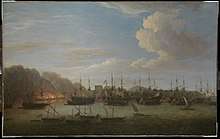HMS Cumberland (1710)
HMS Cumberland was a three-deck 80-gun third rate ship of the line of the Royal Navy, built at Deptford Dockyard and launched on 27 December 1710. Her design corresponded to that laid down by the 1706 Establishment of dimensions for 80-gun ships.[1]
 Cumberland | |
| History | |
|---|---|
| Name: | HMS Cumberland |
| Builder: | Allin, Deptford Dockyard |
| Launched: | 27 December 1710 |
| Fate: | Foundered, 1760 |
| General characteristics as built[1] | |
| Class and type: | 1706 Establishment 80-gun third rate ship of the line |
| Tons burthen: | 1,308 tons BM |
| Length: | 156 ft (47.5 m) (gundeck) |
| Beam: | 43 ft 6 in (13.3 m) |
| Depth of hold: | 17 ft 8 in (5.4 m) |
| Propulsion: | Sails |
| Sail plan: | Full rigged ship |
| Armament: |
|
| General characteristics after 1739 rebuild[2] | |
| Class and type: | 1733 proposals 80-gun third rate ship of the line |
| Tons burthen: | 1,401 tons BM |
| Length: | 158 ft (48.2 m) (gundeck) |
| Beam: | 45 ft 5 in (13.8 m) |
| Depth of hold: | 18 ft 7 in (5.7 m) |
| Propulsion: | Sails |
| Sail plan: | Full rigged ship |
| Armament: | 80 guns of various weights of shot |
On 4 September 1733 she was ordered to be taken to pieces and rebuilt at Woolwich according to the 1733 proposals of the 1719 Establishment. She was relaunched on 11 July 1739. In 1747, she was reduced to a 56-gun ship.[2]

Cumberland sank while anchored off the Indian port of Goa on the night of 2 November 1760. Her captain, Robert Kirk, faced a court martial for the loss of his ship, but was acquitted. The court found that Cumberland's sinking "proceeded from her being entirely decayed, and not in a condition to have proceeded to sea."[3]
Notes
- Lavery, Ships of the Line vol. 1, p. 167.
- Lavery, Ships of the Line vol. 1, p. 170.
- Clowes 1898, pp. 303-304
References
- Lavery, Brian (2003). The Ship of the Line - Volume 1: The development of the battlefleet 1650-1850. Conway Maritime Press. ISBN 0851772528.
- Clowes, William Laird (1898). The Royal Navy: A History From the Earliest Times to the Present. 3. London: Sampson, Low, Marston and Company. OCLC 645627800.